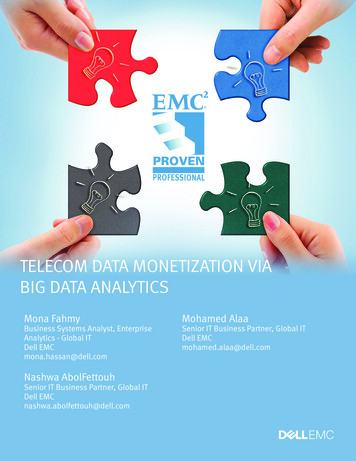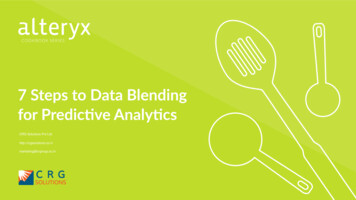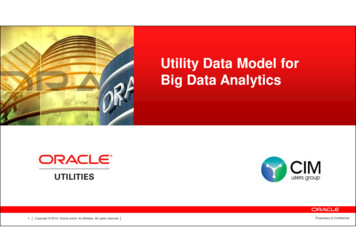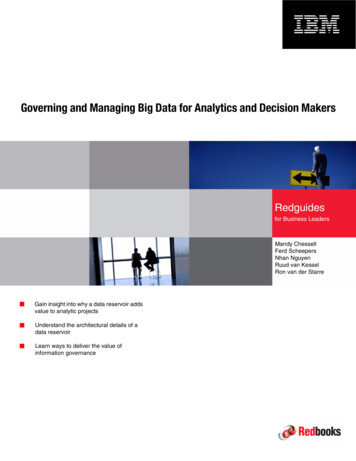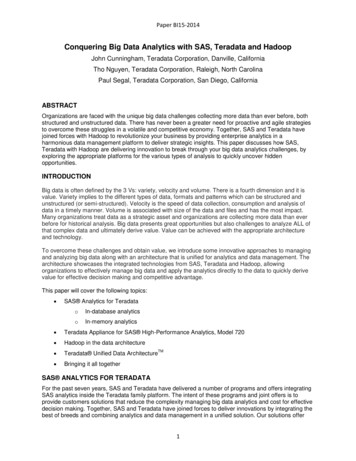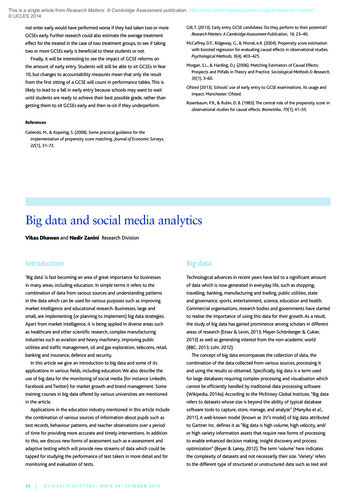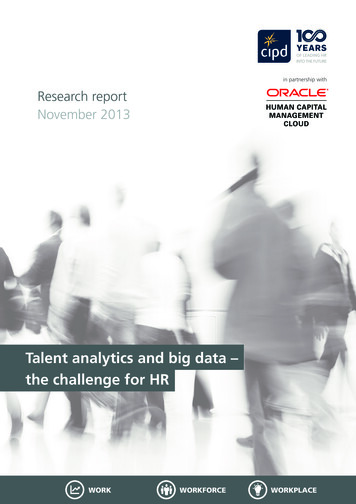
Transcription
in partnership withResearch reportNovember 2013Talent analytics and big data –the challenge for HRWORKWORKFORCEWORKPLACE
Championing better work and working livesThe CIPD’s purpose is to champion better work and working lives by improving practices in people andorganisation development, for the benefit of individuals, businesses, economies and society. Our research work playsa critical role – providing the content and credibility for us to drive practice, raise standards and offer advice, guidanceand practical support to the profession. Our research also informs our advocacy and engagement with policy-makersand other opinion-formers on behalf of the profession we represent.To increase our impact, in service of our purpose, we’re focusing our research agenda on three core themes: the futureof work, the diverse and changing nature of the workforce, and the culture and organisation of the workplace.WORKWORKFORCEOur focus on work includes whatwork is and where, when and howwork takes place, as well astrends and changes in skills andjob needs, changing careerpatterns, global mobility,technological developments andnew ways of working.Our focus on the workforce includesdemographics, generational shifts,attitudes and expectations, thechanging skills base and trendsin learning and education.WORKPLACEOur focus on the workplace includes how organisations areevolving and adapting, understanding of culture, trust andengagement, and how people are best organised, developed,managed, motivated and rewarded to perform at their best.About usThe CIPD is the professional body for HR and people development. We have over 130,000 members internationally– working in HR, learning and development, people management and consulting across private businesses andorganisations in the public and voluntary sectors. We are an independent and not-for-profit organisation, guided inour work by the evidence and the front-line experience of our members.
Talent analytics and big data – the challenge for HRContentsExecutive summary2Introduction31 Silos: what’s getting in the way?72 Skills: rocket scientists or aligned analysts?103 Big data: a big ask for HR?134 Suspicion and scepticism about data and evidence165 Strategies and sThe CIPD wishes to thank all organisations that participated in our research, both indirectly through providing uswith data from our HR and L&D surveys and directly from the organisations we were able to profile. Those whoattended our engagement events – including our July forum event and our Google hangout on September 20 –also contributed, as did participants at the City HR forum. Thanks are due to Oracle – especially Andy Campbell,HCM Strategy Director, and his marketing colleague Saurabh Rastogi – for sponsoring this key area of research.We’d also like to thank the various thought leaders who have shared their insight.1Talent analytics and big data – the challenge for HR
Executive summaryTalent analytics and big data arenow must-have capabilities in HR.As the business world is transformedby the sheer volume, speed andavailability of data, and as the searchfor competitive advantage intensifies,data about people and performancebecomes ever more critical. Muchhas been written on the issue oftalent analytics, but most of thisdebate has focused around three keydimensions:organisations embarking on thetalent analytics journey, we areable to shed some light on thisquestion. Generally, the capacityand engagement for analytics andbig data is affected by three keydimensions:TechnologyWhat systems, processes andinfrastructure drive data and talentanalytics? What platforms arebeing used and how can we usesystems such as Oracle, Hadoopand the like to develop a coherentdata strategy?SilosSilos are the structural and systemsobstacles to timely and efficientaccess to data and the ability touse and share it. This is caused bya combination of structural barrierswithin both HR and the businesswhich impede the sharing of data.The system silos are those pertainingto infrastructure around dataanalysis with issues such as systemsincompatibility, security and hostingconcerns, and IT skills issues.TechniquesHow should we develop an approachto talent analytics? How should wedefine, store and share data? Howshould it be analysed? This aspectcovers everything from definingemployee turnover to predictingpatterns of employee behaviour.Skills and smartsThis includes the essential capabilityto define, analyse and model peopleanalytics essential to a data-drivenapproach. This involves decidingwhether to make or buy capability,what kinds of capability are requiredand how it is developed.TalentWho should deliver our analyticscapability? Should we develop newtalent pools and, if so, what types?How do we recruit the scarcetalent to resource this growingcapability need?Suspicion and scepticismThese are the cultural andprofessional obstacles tointegrating and embedding ananalytical approach within HR.This includes the biases and beliefsaround intuition and expertisewithin HR, and feeling that datamight reduce human beings tounits of measurement. It’s alsobound up with the skills andcapability issue.There seems to be less focus onwhat is actually happening. Whatis the appetite on the ground fortalent analytics and big data? Whatare the barriers and enablers todeveloping this capability and whatis happening within organisations?Using our extensive research onthe state of practice in the HRprofession and key interviews with2In order to help HR develop acoherent approach we developsome strategies and solutionsaround balancing the strategic andtactical requirements of developinga data-driven strategy.SolutionsStrategicOur survey research shows thatthese are considerable challenges,but practice we discovered amongorganisations undertaking thechallenge shows that there aresolutions. These are based ondeveloping a strategic and tacticalmindset which: develops analytics as a continuousimprovement strategyputs people analytics at thecentre of business prioritiesaccelerates the requirement foranalytic bandwidth up the HRcapability agenda.Tactical Identify and promote the skillsnecessary as part of the overallHR talent and capability agenda. Source more key talent fromsubjects such as occupationalpsychology, economics and othersocial sciences to supplementthe normal reliance on naturalscientists and engineers. Develop aligned analysts whounderstand and connect withthe people agenda and arecapable of translating data intoactionable insight.Finally, by looking at the emergingstate of practice, both through oursurvey research and by interviewingpractitioners, the CIPD and Oraclehave put the analytics challengeat the centre of HR, adding to theexcellent insight already developedby leading consultancies, academicsand HR networks such as the CityHR Association. We recognise thatthe challenge is to get value fromanalytics. And we hope this reportwill bring value to those seeking toengage with this crucial agenda.Talent analytics and big data – the challenge for HR
IntroductionYou won’t go far these dayswithout someone analysing yourdata. Whether it’s a supermarketusing your passion for chocolateor driving magazines to makesure you pick one up on yournext order or a council wantingto improve its understanding ofits ‘citizen base’ through surveys,everyone wants to analyse you.Many of the organisations we workin operate on the principles ofadvanced analytics. For example,banks generate a whole array ofdata about where people live,their credit history and spendingpatterns, as well as lifestyledecisions such as birth, marriageand death. Similarly, companiesin the retail sector use predictiveanalytics to estimate how to stockup on sausages for a barbecueweekend and how to upskill theirstaff to sell the latest smartphone.The idea of data as a businessprediction tool is not new or novel,but the intensity and sophisticationwith which it’s now being used isquite new. Business departmentssuch as marketing and logisticsand specialised agencies operatingin many different sectors fromhealthcare to education pore overmetrics and data trying to sort andcategorise what it shows. Datais everywhere and its volume hasrecently been supersized by therise of ‘big data’ with its volume,velocity and variety (McAfee andBrynjolffson 2012).We would add a further V – that ofvalue. In other words, what is thevalue of data to the organisation?The evidence suggests that it ispotentially limitless. Mining thedata for insights and combing it forconnections is a critical opportunityfor HR and L&D (see Manyika etal 2011). Big data is essential toHR and L&D because it allows theconversations and connectionswhich have tended to be in therealm of the immeasurable tobe captured and leveraged. Itallows us to build a compellingcase of interventions, for examplewhen we are proposing changeand transformation. It gives us anew set of insights, around thedeep and complex organisationalissues such as culture, changeand learning, and it helps usto optimise the way in whichwe deliver and monitor thetransactional elements of HR.‘Big data isessential to HRand L&D becauseit allows theconversationsand connectionswhich havetended to be inthe realm of theimmeasurable tobe captured andleveraged.’Figure 1: Gartner’s three ‘V’s of big data3Faster data at higherspeeds than ever before,even in remote locations.Real-time data.VarietyEvery second more datacrosses the Web than waspresent across the wholeInternet in 1993. Cloudoffers massive increase instorage.VelocityVolumeClear and present challenge: big dataMore data on moreaspects of life and workon a greater range ofdevices and channels,from smartphones toembedded chips.Talent analytics and big data – the challenge for HR
‘.there is still asignificant gapin our ability asHR professionalsto be datadriven andevidence-basedin our decisions.’However, the evidence suggeststhat HR may be less ready thanit needs to be in order to takeadvantage of that opportunity.For example, there is still asignificant gap in our ability as HRprofessionals to be data-driven andevidence-based in our decisions(for example, our HR Outlookdata for winter 2012–13 indicatethat while 63% of HR leadersthink they draw insight from data,only about a fifth of their non-HRbusiness counterparts share thatconfidence). For many reasonsour skill sets tend towards theless analytical side of the skillsdivide. We have both valued andfelt more comfortable with theability to interpret ambiguity andcontext, interpreting the shiftingcultures of organisations andthe interactions of their people(see Pfeffer and Sutton 2006).Professor John Boudreau, a leadingUS-based advocate of a moreanalytical HR function, sees HR’sinability to step out of servicedelivery towards a decision scienceapproach as being about skillsand behaviours. Boudreau believesthat the flakiness and variety ofapproaches to measurement in HRcan be contrasted with the rigorousconsistency of areas such as financeand logistics and even marketing.HR, he argues, does not adopt adecision science framework, withan absence of logical data andevidence-based decision-makingacross the profession (Boudreauand Ramstad 2007).Let’s be clear – there is real valuein these skills and the insightsaround people and they are valuedFigure 2: HR draws insight from data to stimulate change and improvement in theorganisation (% agreeing)HR leaders63%Business leaders21%Source: CIPD HR Outlook winter 2012–13, A varietyof leader perspectives. Appendix; survey results.Base: HR Leaders: 107; Business leaders: 3694Talent analytics and big data – the challenge for HR
by leaders. However, without theability to have disciplined data andconsistent analysis, such insightbecomes marginalised.HR has a long way to go to alterthese perceptions of a lack ofengagement and aptitude foranalytics. However, as we willexplain, this isn’t necessarilyattributable to a lack of enthusiasmand commitment. Significantbarriers exist to HR’s ability to bothexplore and exploit talent analyticsand big data for value-addingpeople insight.In addition to the absence ofconsistent data, another argumentas to why HR do not adopt adecision science and human capitalfocus concerns a perceived lackof skills within HR to analyse thedata. Many HR people are reluctantto engage with numbers or arepassive towards them. Indeed,developing the ability to use datato inform organisational decisionswas identified by HR leaders asa priority area for building HRcapability, according to the CIPD HROutlook survey cited above.Where HR people do use metricsthey tend to rely on tried andtrusted metrics generally aroundthe workforce size, how it gets paidand how it learns. These numbersare often generated by HR andare specific to HR. Boudreau andJesuthasan (2011) suggest that thisneed for a home-grown specificsolution creates a lack of reliabilityand inconsistency in data itself.Separately, these HR-specificmeasures tend to focus on pastperformance. How many peoplehave we employed and how muchdo they earn? What numbers havebeen trained in the last year andhow much time did it take? Howmany people left last year andwhat are the associated ratios? Thiskind of approach tends to build arear-view mirror mindset. It distractsand constrains us, just as a driverfocusing on the rear-view is unableto see an opportunity to overtakeand could be in danger fromoncoming traffic. Vance Kearneyof Oracle is clear on the danger ofbeing backward-focused:Looking for talent marketintelligence is a big part of my joband, I suggest, every capable HRD.Yet we are still doing salary surveysto drive those benchmarks. It isthe bluntest possible approach.Do we ask: are the job matchescorrect, do they capture theemerging trends?‘Many HR peopleare reluctantto engage withnumbers or arepassive towardsthem.’Kearney certainly does not believethat we do operate in this forwardfocused manner.Figure 3: HR links its data to busi
Thanks are due to Oracle – especially Andy Campbell, HCM Strategy Director, and his marketing colleague Saurabh Rastogi – for sponsoring this key area of research. We’d also like to thank the various thought leaders who have shared their insight. 2 Talent analytics and big data – the challenge for HR 3 Talent analytics and big data – the challenge for HR Talent analytics and big data .



